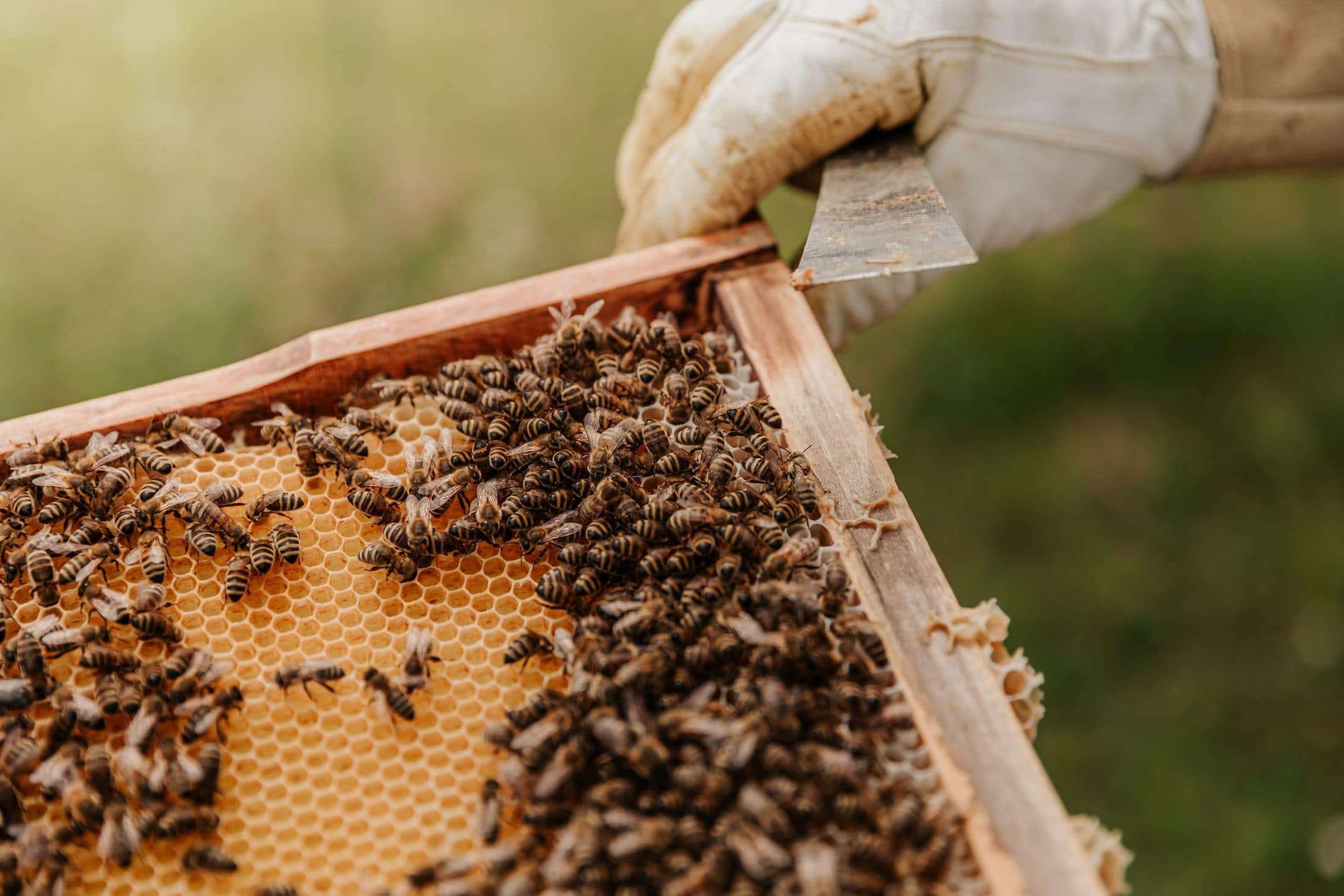Honey bees are mainly characterized by producing and storing honey and constructing nests built from wax. Currently, there is a total of 44 species and subspecies of a honey bee in the genus Apis. There were historically up to 11 different kinds of a honey bee. Honeybees only comprise a small proportion of the roughly 20,000 known bee species. Related types of bees produce and store honey, but these species are not true honey bees according to modern classification. The study of honeybees is called apiology.
Bees have pollen baskets on their legs for carrying pollen back to the hive . The wings of honey bees are transparent, but they appear reddish due to the dense pitting of individual microscopic hexagonal colour cells. The abdomen has five segments; in all species except the stingless honey bee “A. apis” and seven other closely related species, the first three segments enclose the honey stomach and honey intestines, while the last two are the brood segments . The honey bee heart is a primitive one-chambered muscle pump; its upper part consists mainly of sclerites (exoskeletal plates) that form a tough protective wall. In front of this is a strong transverse septum with many circular muscles attached. At the rear end of the digestive tract, honeybees have an anus at right angles to their rectum; as all honeybee larvae retain what they eat until they emerge as adults, this requires special mechanisms for undigested material to be excreted.

The mouthparts consist of a pair of mandibles used for both nectar gathering and food manipulation and another pair of mandibles used for food manipulation. The maxillary palp is a small sensory organ that can be used to taste the nectar, and honeybees have been observed to “taste” flowers. As with all insects, honey bees communicate with one another through chemicals known as pheromones.
The honeybee has three pairs of legs on the middle segments of the body ( thorax ) and only one pair of legs on the hindmost segments of their bodies ( abdomen ). Aside from those involved in carrying loads, most honey bee legs do not extend beyond the body, so they move in a constant downward motion due to gravity .Their legs are covered with fine hairs called scopa , formed by combing 1-2 mm long spinules of wax . They also have two kinds of hairs on the body, including velvety fuzz covering the whole body except for the head and translucent hairs ( adapted specifically to help honeybees collect nectar from flowers ) growing in distinct bands on most body segments. The main distinction between honey bees and closely related nonsocial bee species is the structure of their wing veins; honey bees possess three vein pairs while most other bees have only one or two .

Honey bee colonies typically contain tens of thousands of workers , a few hundred drones, and one queen. A typical honey bee worker has a life span of 45–60 days, during which time she will perform any number of tasks within the colony. These include cleaning, temperature regulation, building, foraging, honeycomb construction, nutrient gathering, and guarding the hive . Worker honey bees feed on nectar and other secretions from flowers for meals directly to their stomachs. When the honey has been returned to the hive, it is deposited into honeycomb cells using their lower jaws.
Honey bee queens can lay around 200 eggs per day during peak season. She is considered a “mother” of the honeybee colony because her sole job is to lay eggs; she uses sperm stored from last year’s mating flight to fertilise them. In temperate areas, queens beginnue one generation (reproduction cycle) at a time when brood clusters are initiated either by themselves or with newly hatched workers in late winter or early spring after hibernation. The honey bee queen can lay over 2,500 eggs per day and is the only fertile female in a colony. When newly hatched larvae emerge as adults they are fed royal jelly for a few days until their worker status becomes more fixed, whereupon they are switched to honey and pollen . Larvae from unfertilized eggs develop into drones (males), whereas those from fertilized eggs develop into females.
The honeybee life cycle consists of three phases—egg , larva , and pupa —that will last about 21 days if there are no delays between them; this duration can vary depending on environmental conditions such as temperature or food availability. Eggs laid by the queen hatch in 3–11 days depending on the ambient temperature, resulting in larvae that, despite being fed honey and pollen , do not grow to be as large as those of some hive-based species. Larvae emerge from their eggs ready to feed on honey, pollen ,and royal jelly . Around the fourth day after hatching, they start to secrete the wax used for honeycombs by anexocrine glands located in their heads. The secretions are moved along ducts and extruded through the sting sheath (at the tip of the abdomen). They spend roughly nine days developing into pupae —this is when they undergo metamorphosis to develop wings and become adult honey bees. When development is completed, all but fertile females ( future workers ) will be killed off inside diapause cells by the workers in a process called honey bee worker policing .
Honey bees perform an important economic activity as pollinators of crops . Their annual value to agriculture is estimated to be greater than $14 billion worldwide. honey bees are also farmed throughout the world for honey and beeswax .
